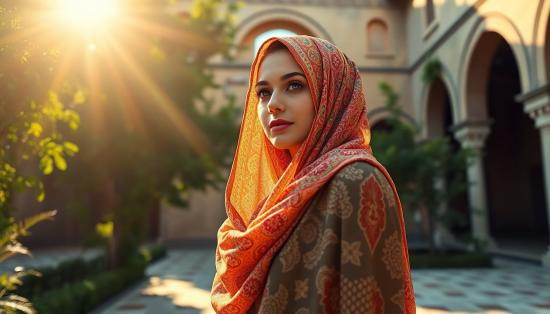-
Close
-
Categories
-
My Bag
-
My Wishlist
-
My Viewlist
-
Login / Reg
Country Language and Currency


Published on March 28, 2023

Have you ever wondered why some Muslim women choose to wear a headscarf? The Hijab isn't just cloth. It's about modesty, respect, and personal space. It's more than just covering your head. This article explores the cultural meaning behind the Hijab in Islam.
Hijab in Islamic Texts and Interpretations
Many Muslims refer to the Quran and Hadith to understand Hijab. Different groups and scholars have different ideas about it. Let's explore what the holy texts actually say.
Quranic Basis for Hijab
The Quran speaks about modesty. Surah An-Nur (24:31) tells women to cover themselves modestly. Surah Al-Ahzab (33:59) talks about drawing their cloaks over themselves. These verses offer a basis for understanding modesty in Islam.
Hadith and the Prophet's Teachings
Hadith refers to the sayings and actions of Prophet Muhammad. They provide details about modesty. The Prophet�s teachings encourage appropriate dress for women. These texts elaborate on modest clothing.
Diverse Scholarly Opinions
Scholars have diverse views on Hijab. Some take a stricter approach. Others are more progressive. These varying viewpoints shape how women practice Hijab.
Hijab as a Symbol of Identity and Community
Hijab helps a Muslim woman define who she is. It creates a sense of belonging. It connects her to the global Muslim community (Ummah). How does it do that?
Personal Expression and Empowerment
Hijab can be a personal choice. It allows women to define themselves. It pushes back against Western beauty standards. Some feel empowered by it.
Solidarity and Sisterhood
Wearing a Hijab can create sisterhood. It builds a shared identity among Muslim women. This leads to support and connection. It builds unity, too.
Countering Misconceptions
People often misunderstand Hijab. They think it's oppressive. This isn't always true. Many women choose to wear it.
Hijab and Cultural Variations Across the Muslim World
The style of Hijab differs. It varies across different regions and countries. Local traditions affect how it's worn. Let's examine these styles.
Regional Styles and Customs
Some places use simple headscarves. Other places have face coverings. Styles range depending on location. Each has its own unique characteristics.
Influence of Local Traditions
Local culture shapes Hijab designs. Communities adapt it to their customs. Traditions play a huge role in its appearance.
Socioeconomic Factors
A woman's job or education impacts Hijab choice. Education and employment influence this decision. It is all tied to the choices.
Hijab in the Modern World: Challenges and Opportunities
Muslim women face challenges today. They also find opportunities. Wearing Hijab in Western countries can be tough.
Discrimination and Islamophobia
Some face unfair treatment due to their Hijab. This can happen at work, school, or in public. Islamophobia is a real problem.
Fashion and Modesty
There's a growing trend of modest fashion. Muslim women show their style with Hijab. They get creative with their clothing.
Activism and Advocacy
Some Muslim women fight for understanding. They challenge stereotypes about Hijab. They speak out and make a difference.
The Abaya: A Garment Complementing Hijab
The Abaya is often worn with the Hijab. It's popular in Gulf countries. It's a flowing garment that adds to modesty.
Historical Context of the Abaya
The Abaya has been around for a while. Its look has changed over time. It carries a rich history.
Regional Variations in Abaya Design
Abayas come in different colors and styles. Each region has its unique designs. They hold cultural meaning.
Abaya as a Statement of Modesty and Elegance
The Abaya looks elegant and modest. Women use it to follow Islamic principles. They also show their personal style.
Conclusion
The Hijab has deep cultural meaning in Islam. It has different meanings and expressions. It's important to respect Muslim women's choices about Hijab. It's their expression, and their decision.